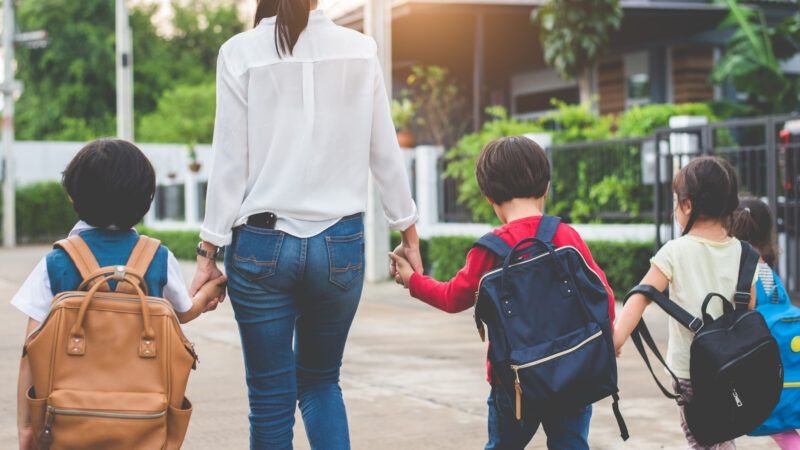Even Kindergartners Should Be Allowed To Walk To School: Study
A new report finds that "most children benefit from some degree of independence by the time they are 5–6 years old."

Child protection laws and policies that determine at what age kids can do things on their own are often misaligned with actual child development—and grossly underestimate kids' capabilities—according to a new paper in Social Policy Report.
A country that investigates or arrests parents who let their kids walk the dog at age 8, or go to the donut store at 7 and 9, or wait in the car at age 11, is at odds with biological, psychological, and cross-cultural evidence showing just how competent kids are. This misapprehension is reflected in our child neglect laws. One in three U.S. kids will be reported to child protective services at some point in their childhood, usually for alleged neglect.
The paper's authors are Rachel Flynn, Nicholas Shaman, and Diane Redleaf; Flynn and Shaman are psychology professors, and Redleaf is a civil rights attorney who works with Let Grow, my nonprofit. They reviewed child development research and ethnographic studies to determine the age at which kids are objectively ready for some "healthy childhood independence."
There is no exact age that covers every kid in every situation, of course. But in general, the authors found that "children's roles and responsibilities in their social setting often undergo a qualitative shift around 5–7 years old." In fact, in many communities, "children as young as 5 years old take responsibility for caring for younger children."
Meanwhile, here in the U.S., Melissa Henderson was arrested for letting her 14-year-old babysit.
The authors used walking to school as the quintessential activity to illustrate each facet of child development. From a physical perspective, they report, most kids ages 6 and 7 have all the skills needed to walk or ride to school. (Having walked to kindergarten, I'd say that kicks in even sooner.)
Cognitively, kids know how to listen and respond appropriately by age 4. By 4 or 5, they can understand what a map represents.
By 5, children are also ready to start their formal education, which requires the ability to "wait rather than immediately act on their impulses, remember what they are told, interact reasonably well with others, and control themselves most of the time." Those are the same social and emotional skills needed for a walk to school.
In short: "Most children benefit from some degree of independence by the time they are 5–6 years old."
And yet, here in the U.S., many schools will not let kids get dropped off at the bus stop, even a few houses from where they live unless an adult is there to accompany them home. These rules can cover kids through ages 8 or 9. Many libraries don't allow school-aged kids to browse alone. County guidelines across northern Virginia say no child under age 9 should ever be unsupervised, even in their own yard.
Sanity is prevailing, however. Virginia just became the fifth state to pass Let Grow's "Reasonable Childhood Independence" law, which says that neglect occurs when parents put their children in obvious, serious danger—not any time they take their eyes off them.
Unfortunately, the Social Policy Report paper found "the overwhelming majority of states" still have laws and policies that treat unsupervised kids as automatically neglected.
Competence doesn't magically kick in at a certain age. It grows with experience. By forcing kids to be chaperoned while walking home from school until age 9, 10, or even 11, kids aren't getting the chance to develop responsibility, autonomy, and problem-solving skills.
That's why the paper calls on states and localities to "remove language in laws and policies that set age limits for independent activities." Moreover, states should use "scientific knowledge rather than presumptions" to decide if kids are ready for some unsupervised activities.


Show Comments (41)